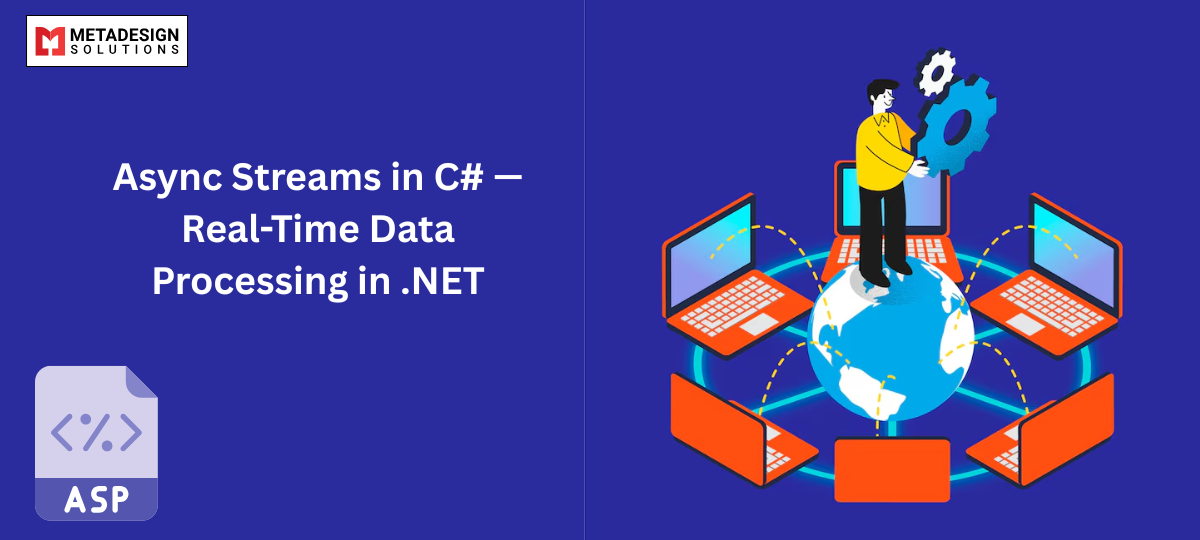Introduction
In today’s data-driven world, applications often need to process large volumes of data or handle real-time updates efficiently. Traditional synchronous methods can lead to performance bottlenecks and unresponsive applications. To address these challenges, C# introduced async streams, enabling developers to work with asynchronous data sequences seamlessly. How can ASP.NET applications benefit from async streams when performance and scalability are on the line? This article explores async streams in C#, their implementation, and how they facilitate real-time data processing in .NET applications.
Understanding Async Streams in C#
Async streams, introduced in C# 8.0, allow developers to asynchronously iterate over data sequences using the IAsyncEnumerable<T> interface. This feature combines the benefits of asynchronous programming with the familiar iteration patterns of synchronous collections, providing a powerful tool for handling data that arrives over time.
Key Components of Async Streams
- IAsyncEnumerable<T> Interface: Represents an asynchronous iteration over a collection of a specified type.
- await foreach Loop: Enables asynchronous iteration over an IAsyncEnumerable<T> sequence.
By utilizing these components, developers can create methods that produce data asynchronously and consume them using asynchronous iteration, leading to more responsive and efficient applications.
Implementing Async Streams
Producing Async Streams
To create an asynchronous data source, define a method that returns IAsyncEnumerable<T>. Within this method, use the yield return statement to yield elements asynchronously.
Example: Generating a Sequence of Numbers Asynchronously
public async IAsyncEnumerable<int> GenerateNumbersAsync(int count, int delay)
{
for (int i = 1; i <= count; i++)
{
await Task.Delay(delay); // Simulate asynchronous work
yield return i;
}
}
Optimize Your Real-Time Data Processing
Looking to enhance your application’s performance with asynchronous data streams? Schedule a consultation with MDS to implement async streams in your .NET applications.
In this example, the GenerateNumbersAsync method asynchronously yields a sequence of integers, introducing a delay between each number to simulate asynchronous operations.
Consuming Async Streams
To consume an async stream, use the await foreach loop, which allows asynchronous iteration over the data sequence.
Example: Consuming the Asynchronous Sequence
public async Task ProcessNumbersAsync()
{
await foreach (var number in GenerateNumbersAsync(10, 500))
{
Console.WriteLine($"Received number: {number}");
}
}
In this example, the ProcessNumbersAsync method asynchronously iterates over the numbers produced by GenerateNumbersAsync, processing each number as it becomes available.
Real-Time Data Processing with Async Streams
Async streams are particularly beneficial for real-time data processing scenarios, such as monitoring live data feeds, processing sensor data, or handling user-generated events. By processing data elements as they arrive, applications can provide timely responses and maintain high performance.
Example: Monitoring a Live Data Feed
public async IAsyncEnumerable<string> MonitorDataFeedAsync(Uri feedUri)
{
using var client = new HttpClient();
while (true)
{
var data = await client.GetStringAsync(feedUri);
yield return data;
await Task.Delay(1000); // Polling interval
}
}
In this example, the MonitorDataFeedAsync method continuously fetches data from a specified URI, yielding each data chunk asynchronously with a delay between requests to control the polling rate.
Consuming the Live Data Feed
csharp code:
public async Task ProcessDataFeedAsync(Uri feedUri)
{
await foreach (var data in MonitorDataFeedAsync(feedUri))
{
Console.WriteLine($"Received data: {data}");
// Process the data as needed
}
}
Here, the ProcessDataFeedAsync method asynchronously processes each data chunk received from the live data feed, allowing for real-time data handling.
Best Practices for Using Async Streams
When implementing async streams in your applications, consider the following best practices to ensure efficiency and maintainability:
Handle Cancellation Gracefully: Implement cancellation support to allow consumers to cancel the asynchronous iteration when needed. Accept a CancellationToken parameter in your async stream methods and pass it to asynchronous operations within the method.
Example: Supporting Cancellation
csharp code:
public async IAsyncEnumerable<int> GenerateNumbersAsync(int count, int delay, [EnumeratorCancellation] CancellationToken cancellationToken = default)
{
for (int i = 1; i <= count; i++)
{
cancellationToken.ThrowIfCancellationRequested();
await Task.Delay(delay, cancellationToken);
yield return i;
}
}
- Manage Resource Cleanup: If your async stream method utilizes unmanaged resources or implements IDisposable objects, ensure proper cleanup by implementing the IAsyncDisposable interface and the DisposeAsync method.
- Control Concurrency: Be mindful of the concurrency level when consuming async streams, especially when processing data in parallel. Use mechanisms like SemaphoreSlim to limit the number of concurrent operations.
- Error Handling: Implement robust error handling within your async stream methods to manage exceptions that may occur during asynchronous operations. Use try-catch blocks and consider logging errors for diagnostics.
- Avoid Blocking Calls: Ensure that all operations within your async stream methods are asynchronous to prevent blocking the thread and degrading performance. Use asynchronous versions of methods (e.g., ReadAsync, WriteAsync) when working with streams or I/O operations.
Conclusion
Async streams in C# provide a powerful and efficient way to handle real-time data processing in .NET applications. By leveraging IAsyncEnumerable<T> and the await foreach loop, developers can create responsive applications capable of processing data sequences asynchronously. For any .NET Development Company aiming to build scalable and high-performance solutions, mastering async streams is essential. Implementing best practices such as handling cancellation, managing resources, controlling concurrency, and robust error handling will ensure that your applications are efficient, maintainable, and scalable.
Related Hashtags:
#CSharp #DotNet #AsyncStreams #RealTimeData #DotNetCore #CSharpDevelopment #AsyncProgramming #StreamProcessing #DotNetDeveloper #CSharpAsync #DotNetStreams #RealTimeProcessing #HireDotNetDevelopers #DotNetDevelopmentCompany #AsyncAwait #ReactiveProgramming #SoftwareDevelopmentIndia #CSharpCompany #MetaDesignSolutions #DataStreaming



